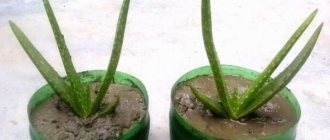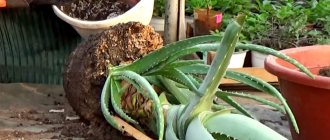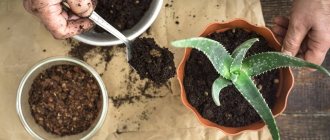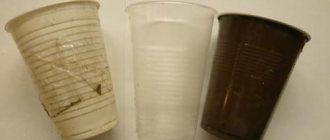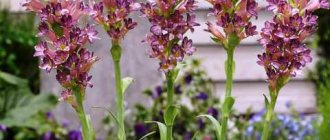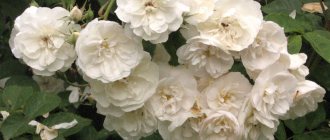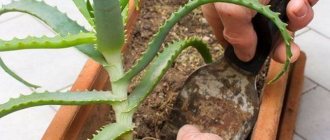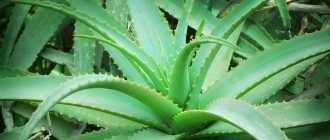Planting Aloe at home is a very common occurrence. This plant is grown primarily for its beneficial properties. Thus, Aloe Vera and Aloe Tree (Agave) have pronounced medicinal qualities. Aloe juice is used to treat inflammatory processes on the skin; it is also a good remedy for the common cold; extracts from the plant are used to produce cosmetics.
However, the appearance of a flower can serve as a decoration for a room. This is especially true for decorative varieties of aloe. For example, Aloe Variegated (otherwise known as Tiger). This flower looks very beautiful: small in size, the leaves are decorated with white stripes, spots, specks, and when flowering, beautiful bright orange inflorescences are formed.
Succulents
Aloe grows in large quantities in countries with arid climates (for example, Africa, Madagascar, the Arabian Peninsula). The plant is well adapted to long-term lack of moisture and belongs to the group of succulents. Succulents are a large part of the flora that are interconnected by their ability to adapt to unfavorable environmental conditions, namely long-term droughts. Such specimens have a special structure: thick, fleshy stems and leaves in which moisture accumulates, often characterized by spines, bristles or hairs (these are modified leaves).
22
Aloe perfectly withstands high and low temperatures, can survive without water for a long time, and does not require complex care. Even an untrained novice florist can easily grow this flower at home.
And yet, you need to know some of the features of Aloe breeding if you are truly passionate about plant growing and want to create the most comfortable conditions for your green pets.
Place
An ordinary window sill located in the south or east of the house is good for growing Aloe (the north side is a bad option). It should be well lit, but exposure to open sun is undesirable. Create a little partial shade - and the plant will thank you for your good care.
Use a plastic or terracotta pot as a container for planting a flower. These materials do not allow moisture to pass through well, which is good for the plant. The size of the planting container should be such that the root system feels spacious (there should be a gap of 3 cm between the walls and the root). We choose a pot with a shallow depth.
Advice! To determine whether there is enough space for a plant to stay comfortably, focus on the ratio of the length of the leaf to the diameter of the planting container: a ratio of 2:1 would be ideal.
Which pot is suitable for aloe
It is recommended to plant and replant the plant in the spring, since the aloe has already faded. The first transplant is carried out after a year, subsequently the period increases to once every 2-3 years. Aloe Vera has a fibrous root system. The root shoots resemble a cone shape - the roots are long cylindrical in shape.
The plant collects moisture at the tips of its roots, which means it needs to be watered not in a pot, but closer to the roots - in a tray. It is necessary to take into account these features so as not to make a mistake and the aloe does not die.
Features of choice
In stores you can find pots made of plastic or clay. There is no right choice of material.
Therefore, it is worth talking about the pros and cons of the proposed options. Plastic: lightweight and cheap pots that do not break if dropped, but often crack if handled carelessly. It is easy to make additional holes if the existing ones are not enough for the flower to exist comfortably.
Clay: the walls of such a container have a porous structure and do not contribute to the stagnation of moisture (therefore, the flower will need to be watered more often); the walls also withstand the attack of hot sunlight and protect aloe roots from high temperatures. Durable in use, unlike its plastic competitor.
You should not plant the flower in a large container, as this promotes the formation of alkali. If you allow a high concentration in the soil, the roots will begin to rot.
Important! There should be 1-2 cm of free space between the roots, walls of the pot and its bottom.
It is worth paying attention to the crown of the flower. The size of the container should be 2 times smaller than the diameter of the plant (the gap between the opposite aloe leaves).
Let's summarize. When choosing a pot, you must comply with the following conditions: 1. The presence of drainage holes at the bottom. 2. When replanting a plant, pay attention to the previous container: the volume should increase by at least 3 cm. 3. If the root system is wide, then you will need a pot with a much larger diameter. 4. If the roots grow deeper, then a higher pot is needed.
Source
Priming
To plant Aloe, you can purchase ready-made soil for succulents. But if you want to prepare the soil yourself, you need to consider the following points:
- The soil should have good air permeability.
- It is advisable not to add peat to the composition.
- Recommended acid-base balance: neutral or low acidity.
In order to increase the airiness of the soil, the following loosening elements are used: river sand with large grains of sand, small broken brick, perlite, shells, expanded clay gravel.
The substrate usually includes the following components:
- A layer of clay mixed with a layer of turf.
- Sand or any other drainage layer.
- Leaf soil.
- Humus.
All elements are taken in equal shares. Drainage is placed at the bottom of the pot, then a layer of soil mixture, gravel pebbles or a layer of coarse sand are placed on top of the substrate.
Which pot should you choose?
Ceramic pot
The best for any plant is a simple ceramic pot.
The clay from which it is made is a natural material, such a pot allows the root system to breathe, regulates soil moisture well, looks decent in any interior, and lasts a long time without losing its appearance. And their range is varied, from simple to elegant and very elegant, but all this is secondary, their environmental friendliness comes first.
Plastic pot A plastic pot
has become a worthy replacement for a ceramic pot; flowers grow in it, and the price is much lower. Children's plastic buckets are a thing of the past; they have been replaced by a wide variety of plastic flower containers in shape, color and size. And for lovers of the classics, of course, pots and pots in the color of ceramics, but made of plastic, are suitable.
However, plastic pots have some disadvantages: they do not allow air and moisture to pass through, the soil needs to be loosened, drainage is especially important and the amount at the bottom of the pot should be at least one quarter of the volume.
If we use seeds
With this method, sowing is done in the first months of spring. Prepare the soil in advance and select the required composition. The room temperature should be above 20 degrees. The container for sowing is small and narrow. The seeds are placed on the moist top layer of soil and covered with a thin layer of sand. The seeds should be buried 1 cm.
The seedlings are placed under film or glass and provided with the necessary care. At this time, sufficient watering is important; spraying of overgrown leaves is also used. After three large leaves appear, the seedlings are transplanted into separate small containers (no higher than 5 cm). After one year, the grown-up individuals are transferred to a permanent place in a large pot.
Using not the easiest possible seed propagation method, you can grow an entire plantation of succulents.
Planting material
We are used to buying houseplants we like in a specialized store already in a pot, often already mature and flowering, but we most often find aloe from friends and relatives, in a casual conversation over a cup of tea, we learn a lot of interesting things about the properties of the plant, about who from friends and what exactly was cured with this plant - and we take a piece or baby from the mother plant.
Baby
The easiest way to plant is a young plant, of which there are many growing from the mother bush at its very base. The young aloe is fully formed and its root system is ready for independent life, but is located on the surface of the soil, as if waiting to be transplanted into its own pot. Small plants are called babies, and planting them is the easiest and most reliable option.
Upper part of the stem
The part of the stem that is well suited for propagation is the apex, with two or three pairs of leaves. She should have a strong, healthy appearance. There is no need to plant it right away; let it sit for 5 or 6 days, heal its wounds on its own, and the damaged areas should dry out. However, you can also dip the cuttings in water until roots form. There is information about possible rotting instead of root formation, but in my many years of practice this has not happened, the roots sprouted, the young plants lived in ordinary water for about six months, were transplanted into pots and took root normally
Didn't manage to get hold of a baby or cuttings? It doesn’t matter, a leaf is enough, you need to pick it as close to the mother plant as possible, the smaller the tearing area, the faster the leaf will let go of its roots. There is no need to rush with planting; let it sit for a week, heal the wound, and prepare for planting.
Seeds
This method of propagating aloe is also possible, but it is usually used by succulent collectors to grow decorative, variegated species. You will learn all the details about the propagation and cultivation of aloe here.
Propagation using cuttings, stem shoots, leaves
All these methods are similar to each other. To reproduce each of them, you will need to complete the following steps:
- Select a suitable fragment of the plant and cut it, the knife should be sharpened and washed well,
- The cut area needs to be well dried. The cut part is stored for about a week in the open air in a dark place, treating the cut with rubbed activated carbon.
- The shoot is cut from an adult plant that has up to eight large leaves. After the cut site has dried, the Aloe fragment can be planted.
Advice! Do not immerse a leaf, shoot or cutting in a container of water before planting. This can destroy them because the process of rotting will begin.
If you have chosen a basal shoot for breeding a new individual (they are also called “babies”), then the best time to separate the shoot will be a planned transplant of an adult specimen. You will need a sharp knife to separate the “babies” from the root. Make sure that the “babies” that you cut also have small roots left.
Reproduction using parts of an adult plant is usually carried out in the warm season.
Which pot should you choose?
When planning to move aloe into a new container, you need to know the requirements for the size of the pot. If the container is too large, the soil will leach out, the roots will rot, and the plant will stop developing. Pay attention to the material from which the pot is made.
How to choose the right size?
There are several ways to determine the optimal pot size. It should be such that there is 1–2 cm of free space between the straightened roots and the walls and bottom of the vessel.
The required dimensions are also determined by the crown. A correctly selected container has a diameter that is 2 times smaller than the distance between the edges of opposing leaves. The older the plant, the more powerful its root. That's why they take more pot each time.
Another way to avoid making a mistake with your choice is to compare new and old containers. The diameter should increase by 3 cm.
Material selection
Pots are made of plastic and clay. Each material has its pros and cons. Plastic products have the following advantages:
The advantage of a clay pot is that the water in it does not stagnate for a long time due to the porous structure of the walls. Thanks to this, the roots do not heat up and do not rot even under the scorching rays of the sun. More weight gives stability, which the plastic counterpart does not have.
How to land
After drying the cut, cuttings or leaves are planted in previously prepared soil. They do it like this:
- The leaf is placed in moist soil with the tip down to a depth of three centimeters.
- Cover the cutting or leaf with a glass jar or film.
- Place the container with the seedling in a bright place.
- When planting shoots, choose one that already has up to six leaves. Bury in the ground up to the beginning of the bottom sheet. To give the sprout strength, it is surrounded with small stones. Further cultivation is also carried out in a greenhouse, with proper care of the plant.
- The “babies” are transplanted with roots. If the roots were damaged during the separation of the shoot, they are dried for several days before planting in the ground. Undamaged individuals are planted immediately.
